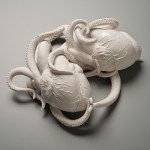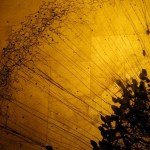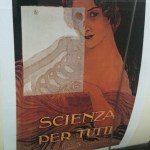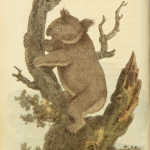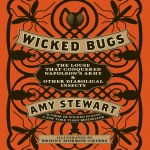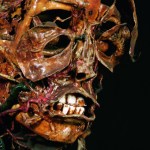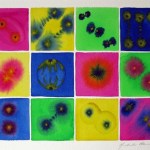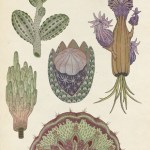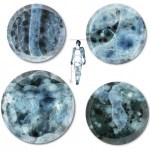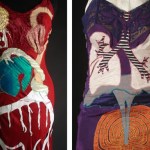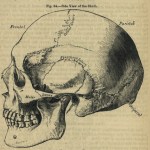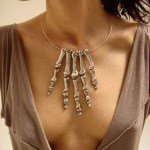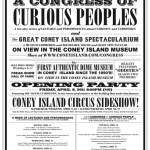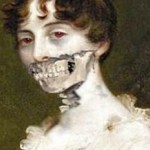Entangled, 2010
handbuilt porcelain, cone 6 glaze
Kate MacDowell sculpts partially dissected frogs, decaying bodies with exposed skeletons, and viscera invaded by tentacles or ants. It's the imagery of nightmares, death metal music videos, or that tunnel scene in the original Willy Wonka (not a speck of light is showing, so the danger must be growing. . . ). But her medium - minimalist, translucent white porcelain - renders her viscerally disturbing subject matter graceful, even elegant. Some of her pieces, like Sparrow, below, play off the porcelain's resemblance to delicate bleached bone.…
Medical Illustration and History
Photo of Vermont highway courtesy of Kyle Cornell
Last week, I had my long-awaited vacation semi-ruined when, thanks to Hurricane Irene, my flight back from the West Coast was cancelled. I had to rent a car and drive across the country in a rush - not my favorite way to spend three and a half days. But based on what I saw passing through New York, and what I've heard about the damage in Vermont, I can't complain: flooding has overturned homes, isolated entire towns, and destroyed everything some families own.
Vermonters are a notoriously self-sufficient bunch, and I haven't seen that much…
Gold Cortex
16 x 20, 2010
Greg Dunn
I used to have a beautiful gold Japanese folding screen, which was purchased by my great-grandmother's feisty sister on a trip in the 1920s. I loved the gold patina and the surprisingly modern impact it had on my wall. At the moment, it's loaned to a friend, but looking at Greg Dunn's artwork, I couldn't help but be reminded of the best aspects of my screen: the gold leaf, crisp black patterns, and way that the scene seemed half natural, half abstract.
The biggest twist Greg, a 6th year graduate student in neuroscience at the University of Pennsylvania,…
Gold Cortex
16 x 20, 2010
Greg Dunn
I used to have a beautiful gold Japanese folding screen, which was purchased by my great-grandmother's feisty sister on a trip in the 1920s. I loved the gold patina and the surprisingly modern impact it had on my wall. At the moment, it's loaned to a friend, but looking at Greg Dunn's artwork, I couldn't help but be reminded of the best aspects of my screen: the gold leaf, crisp black patterns, and way that the scene seemed half natural, half abstract.
The biggest twist Greg, a 6th year graduate student in neuroscience at the University of Pennsylvania,…
From 1810-11, architect and amateur naturalist George Perry published The Arcana, a lavishly illustrated, serial natural history magazine. Although Perry intended for the serial issues to be assembled by his subscribers into a book, only thirteen complete copies are known to survive today. More than a third of the known copies are in Australia - perhaps fittingly, as Perry was the first to publish an illustration of the koala (above).
Perry's work is not well known; in researching this post, all I could find online were auction listings and occasional references to a recent facsimile…
Amy Stewart's new book Wicked Bugs: The Louse That Conquered Napoleon's Army & Other Diabolical Insects takes a fairly trivial concept - a collection of historical anecdotes and icky factoids about dangerous insects - and executes it remarkably well. The book is well-written and has a non-cloying sense of humor ("she's just not that into you," begins the section relating how female praying mantids eat the males). Briony Morrow-Cribbs lends her insect illustrations (see a NYTimes slideshow of her ink illustrations here), and Anne Winslow's design plays off the concept of a vintage…
. . . they could have. Or pretty darn close, at least - they just needed to visit one of the many European cabinets of anatomical curiosities, to see the work of anatomists like Honore Fragonard.
Fragonard's eighteenth-century ecorches were the clear precursors to Gunther von Hagens' "Body Worlds" exhibits: preserved, injected, partially dissected bodies in lifelike, dramatic poses, with ragged strips of muscle draped like primitive clothing over exposed vessels and nerves. The effect is eerie - like a Vesalius illustration sprung to (half-)life:
Man with a Mandible
Several of Fragonard's…
Cell Division IV
Michele Banks
DC area artist Michele Banks has donated one of her cell division watercolors to raise funds for art outreach. Check out the online auction - the painting is matted and framed and currently going for only $52.
Michele is not a biologist, but she's been on a sci-art kick for a while, inspired by the fortuitous resemblance of watercolor patterns to cellular structures. To see more of her work, visit her etsy shop, artologica.
minouette of magpie & whiskeyjack has posted an interesting meditation on the resemblances between Katie Scott's whimsical faux-botanical/biological atlas pages (above), the illustrations of Ernst Haeckel (whose portrait minouette just finished), and the Codex Seraphinianous. It's a harmonious grouping of artistic influences - check it out.
Animated Anatomies, a new show at the Perkins Library at Duke University, explores the tradition of fold-out or pop-up paper anatomical diagrams:
Animated Anatomies explores the visually stunning and technically complex genre of printed texts and illustrations known as anatomical flap books. These publications invite the viewer to participate in virtual autopsies, through the process of unfolding their movable leaves, simulating the act of human dissection. This exhibit traces the flap book genre beginning with early examples from the sixteenth century, to the colorful "golden age" of…
. . . let the table settings do the talking (and the grossing out) for you! These Consumption Dinnerware plates by Leah Piepgras "are a map of the digestive tract, from mouth to anus:"
I'm trying to decide if these plates have a future as a diet aid.* Visualizing the eventual chyme-ish fate of a bolus of taco salad might just induce me to eat less. . . on the other hand, the dreamy blue watercolor palette makes me think of snowflakes, not chyme and gall. And I think I've done too many dissections for a medical illustration to have much of an effect.
Via the design blog CollabCubed.
*you…
Through the end of May, UMBC's Albin O Kuhn gallery is hosting a large exhibition of postmortem daguerreotypes, death masks, coffin plates, etc. from the collection of Dr. Stanley Burns.
Medical ephemera always have an emotional valence, because they represent patients who suffered, struggled and eventually lost their physical battles. But this collection of memorials are about the survivors' needs, not the dead, and are thus particularly eerie and wrenching.
From the curator:
Trace the evolution of postmortem photography through 19th-century daguerreotypes and prints from Sleeping Beauty…
Scapular Art Dress
Rachel Wright
I'm about to go back offline again because I don't feel up to blogging, but I had to share this find from my friend Shana - she does know what belongs on BioE! These are one-of-a-kind art dresses by artist Rachel Wright (Toolgrrl Designs on etsy). Wright says,
This piece is called "Scapular" because of the wing-like velvet shoulder blades that grace the back. The slip is a rayon slip probably from the 50's that I dyed a scarlet red. I then used a variety of different fabrics for the appliqué: velvet, silk for the many petaled breast & kidney, a recycled…
Anatomical engraving from Henry Gray's Anatomy, 1858.
A month or so ago, Abrams books reached out to mention that they were releasing a new title, Human Anatomy: A Visual History from the Renaissance to the Digital Age. I said, "don't I already have this book?" It turns out I did - I had the previous, hardback edition which I picked up for $25 or so on Amazon (a deal, I thought at the time). So I knew this book should really be subtitled "vintage eye candy from Vesalius to Schmiedel," because it's a bundle of rich images from anatomical atlases, interspersed with just enough curation to give…
Haute Macabre found artist Celina Saubidet on etsy, where she sells silver-plated bronze "osseous jewelry" from her shop Joyeria Osea. I think this skeletal hand is pretty over the top, but hey - sometimes you need a little drama. Check out her fingerbone rings for a more subtle anatomical statement.
Shambling, slowly disintegrating zombies aren't good for much - but maybe they're helpful for teaching neurobiology?
The Zombie Autopsies with Steven Schlozman, MD from GCP authors on Vimeo.
It is all about braaaaiiiiiinnns, after all. . . .
Read all about Zombie Autopsies here, or head to Amazon.
The 2011 Congress of Curious Peoples, featuring, among other guests, Anna Maerker, author of Model Experts: Wax Anatomies and Enlightenment in Florence and Vienna, 1775-1815; Mike Sappol, author of A Traffic of Dead Bodies: Anatomy and Embodied Social Identity in Nineteenth-Century America; Elizabeth Stephens, author of Anatomy as Spectacle: Public Exhibitions of the Body from 1700 to the Present; and John Troyer, author of Technologies of the Human Corpse (forthcoming). Whoa.
Learn more here!
A really interesting post from Deborah Blum on the "radium girls" who painted wristwatches in the 1920s - to fatal effect:
At the factory, the dial painters were taught to shape their brushes to a fine point with their lips, producing the sharp tip needed to paint the tiny numbers and lines of watch dials, the lacy designs of fashionable clocks. Each worker was expected to paint 250 dials a day, five and a half days a week. They earned about $20 a week for that work, at a rate of one and a half cents per completed dial.
The painters were teen-aged girls and young women who became friendly…
O designer-readers who like to work and play with Photoshop, this contest may be up your alley: Quirk Books, the outfit behind Pride and Prejudice and Zombies, has joined with Bridgeman Art Library to invite submissions for its "Art of the Mash-Up" competition. Basically, they want you to prove you can do better than the Regency unmentionable pictured above:
The iconic "Zombie Lady" on the cover of the New York Times Best Seller Pride and Prejudice and Zombies captured the imagination of readers around the world and has become one of the most recognizable book jackets in recent history.…
